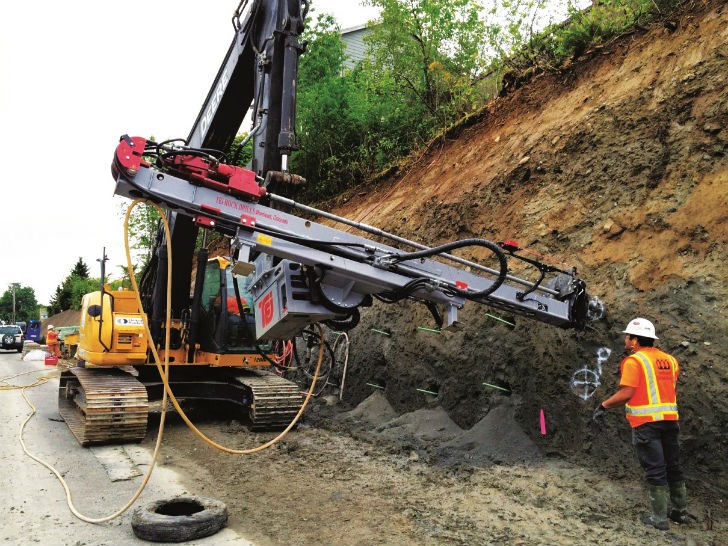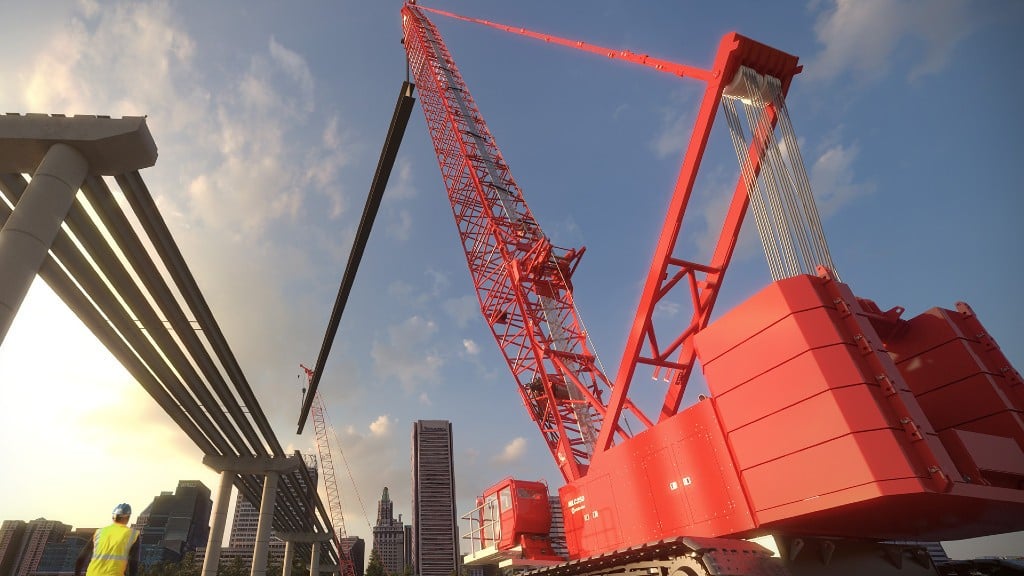Excavator Mast and Top Hammer Solve Complex Geotechnical Drilling Challenge

Geotechnical drilling projects have become increasingly complex where there are severe geologic problems and topographic constraints, such as earthquake zones on the west coast of Canada and the U.S. Pacific Northwest.
Geo-construction practices and tools are being developed at a rapid pace to address geotechnical construction challenges. Innovations in drilling technology from both Europe and the United States have been instrumental in providing the necessary tools and techniques.
A good example is a project in Duvall, Washington, located on glacially formed side slopes above the Snoqualmie River basin. As the Seattle metropolitan area has expanded, more distant areas like Duvall (40 kilometres east of Seattle) have become increasingly popular. Planning and road construction did not foresee the requirements for today’s rapid expansion in the area.
An intersection in Duval recently needed to be widened to install sidewalks and a bike lane. The problem was that the widening required a nine-metre-high, nearly vertical cut into the glacial till, with houses located above the top of slope with a setback of less than six metres. The project was further complicated by the need to maintain street operations adjacent to the slope while construction progressed.
A permanent soil nail and shotcrete wall system was selected by the city as the best alternative to provide slope reinforcement and support for the widening of the intersection. A sculpted faux rock finish was selected for the finish shotcrete to minimize the industrial appearance of the infrastructure improvements.
Finding a solution
The site construction constraints virtually eliminated the use of classic dedicated soil nail drilling equipment, as there was no way to create benches to access the slope cut. In addition, soil conditions and soil nail design diameter and drilling depth required a minimum six-inch diameter hole penetrating up to 20 feet into the very dense glacial soil, comprised of a cemented sandy silt with gravel and cobbles, and a few boulders the size of a small car.
Basically, the wall would have to be constructed by reaching from the base of the slope. The size of the soil nails and drilling conditions limited the installation methods to basket mounted equipment and down-the-hole hammers, or extended reach equipment with moderate or large size top hammers.
As the top hammer system would clearly be the fastest installation method, Northwest Soil Stabilization (NW Soil) chose a TEI excavator mast and TE560 top hammer drifter to install the more than 250 soil nails for the project. The TEI mast was mounted on a John Deere 225 excavator with more than 25 feet of vertical reach to be able to build the wall from the base of the cut.
Soil nail holes were drilled through the very dense glacial till soils utilizing the TE560 drifter and carbide cross cut bits. Air was used to flush the cuttings from the holes. A relatively low air pressure and volume was used to minimize the particle blow out from the hole, and avoid impacts to vehicles and pedestrians on the active street adjacent to the site. Drillers were also very particular about plunging and stroking the holes to flush cuttings, and extra time was taken to assure the holes were adequately cleaned while not allowing blow outs.
Because of the inherent strength of the glacial soil, the general contractor was able to cut from top to base in preparation for the drilling. This allowed complete access to the face with the excavator mounted drill, reducing the wait time between lifts for convention soil nailing. It also allowed the deletion of the temporary shotcrete which provided a cost savings to the owner.
The TE560 has an impact energy and 43 Nm and 400 daNm of rotary torque. The top hammer running the carbide bits cut rapidly through the cemented silt and cobbles/boulders. The high torque capacity was also useful, twisting the larger particles through the drill holes past the bits, and avoiding lockups while drilling. (Button bits were also attempted but maintaining low airflow volume and pressure made plugging a problem as the penetration rates tended to produce cuttings too quickly for the air stream capacity).
Remote control
The TEI mast also performed admirably with the radio remote controls allowing the driller complete control over all drill functions from the cab of the excavator, while maintaining all kinematic controls of the equipment. The system also allowed safe operations for the helper in a man basket suspended up to seven metres above ground.
Production ranged from 15 to 20 nails per day depending on the elevation of the nail installation and the variability in the soil. Nail installation was completed in just 14 working days, with nearly 4,500 total feet of drilling and 10 proof load tests. Shotcrete application required another four days to complete, including carving and staining. Again work was completed from the ground level utilizing man lifts.
TEI drilling equipment allowed the project to be completed safely and effectively, and ahead of schedule. The equipment worked flawlessly in very difficult drilling conditions. The city was pleased with both the process and the outcome – with NW Soil receiving complements on both their work and equipment. The city’s engineer and project manager was very impressed with the TEI excavator-mounted mast and drilling system saying “That is a cool piece of equipment.”



